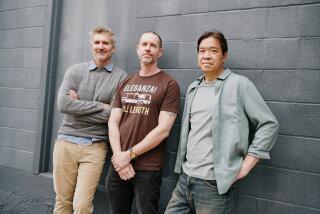‘How We Got to Now’ a fun look at six big ideas, their legacies
- Share via
In “How We Got to Now,” a six-part series premiering Wednesday on PBS, popular science writer and professional theorist Steven Johnson (“Everything Bad Is Good for You,” “Where Good Ideas Come From”) looks at six big ideas and the historical fruit they’ve borne. It is a celebration of unintended consequences, among some intended ones, with funny sound effects.
The basic idea is that a good idea leads to many others — that nothing happens in a vacuum. This includes “How We Got to Now” itself, which bears a marked resemblance to “Connections,” James Burke’s BBC series, seen here on PBS, which also examined civilization’s hidden lineages and legacies.
That is not to say less of the present program: If Johnson sometimes stretches a point to make a point — the link between public hygiene and competitive skateboarding, say — he is always intriguing and entertaining, his show thought-provoking and compulsively fun to watch.
Johnson structures his series (also a book, of the same name) around six big ideas — “Clean,” “Cold,” “Sound,” “Time,” “Glass” and “Light” — that he follows to likely and less likely places. You do not need to be told that glass made windows possible.
Less immediately obvious is that in the form of spectacles, it brings the world into focus; in telescopes, it brings the far near; in microscopes, it makes the little big. In each case, it changes the what, how, when, where and even why of how we live. And yet it’s the sort of thing we tend to forget or to overlook, consumed as we are with the immediate, practical details of living.
The case Johnson makes is that these developments are not merely a question of the right idea at the right time but also of the many almost-right ideas that prepare the ground: that history is built not only on the shoulders of giants but also that giants often stand on the shoulders of more or less normal-sized humans whose names, if not completely lost to history, are not part of the standard curriculum.
“Why has nobody heard of this guy?” is a refrain that runs through the series, when discussing Édouard-Léon Scott de Martinville, the 19th century Frenchman who invented a device that could record sound (as a visual wave form) but not play it back. (It has been played back since, with 21st century software.)
Like many who write about technology — and, I suppose, like most of us, practically speaking — Johnson remains morally neutral, more interested in technology and what it brings to the world than in examining what it takes out of it. That new inventions change, with sometimes blinding speed, what we find necessary to a good life is within his range of interest, but whether these changes are good or bad is not expressed here. That you can go skiing on real snow in Dubai is cool in a way — no pun intended, I swear to you — but possibly less so on a spiritual, social or ecological level. Is the world a better place because of cellphones? Most everyone would say it is; but, you know, maybe not.
Science, as it is conceived and explained, is also a thing of metaphors, poetic analogies and often humor, and “How We Got to Now” has a certain wackiness common to the breed — Johnson is a jovial guide, not beyond dressing up as Thomas Edison or narrating from a bathtub, and the series uses a lot of new animation, along with old, public-domain cartoon and live-action clips to punctuate the action, sometimes as literally as showing a slot machine paying off to accompany the words “hits the jackpot.”
Keep an eye out for the cat sliding down a fire pole — not a cartoon! — which in its small way is as amazing as anything here. I ran it five times in a row.
-------------------------
‘How We Got to Now’
Where: KOCE
When: 9 p.m. Wednesday
Rating: TV-PG (may be unsuitable for young children)
Follow me on Twitter: @LATimesTVLloyd
More to Read
The complete guide to home viewing
Get Screen Gab for everything about the TV shows and streaming movies everyone’s talking about.
You may occasionally receive promotional content from the Los Angeles Times.







